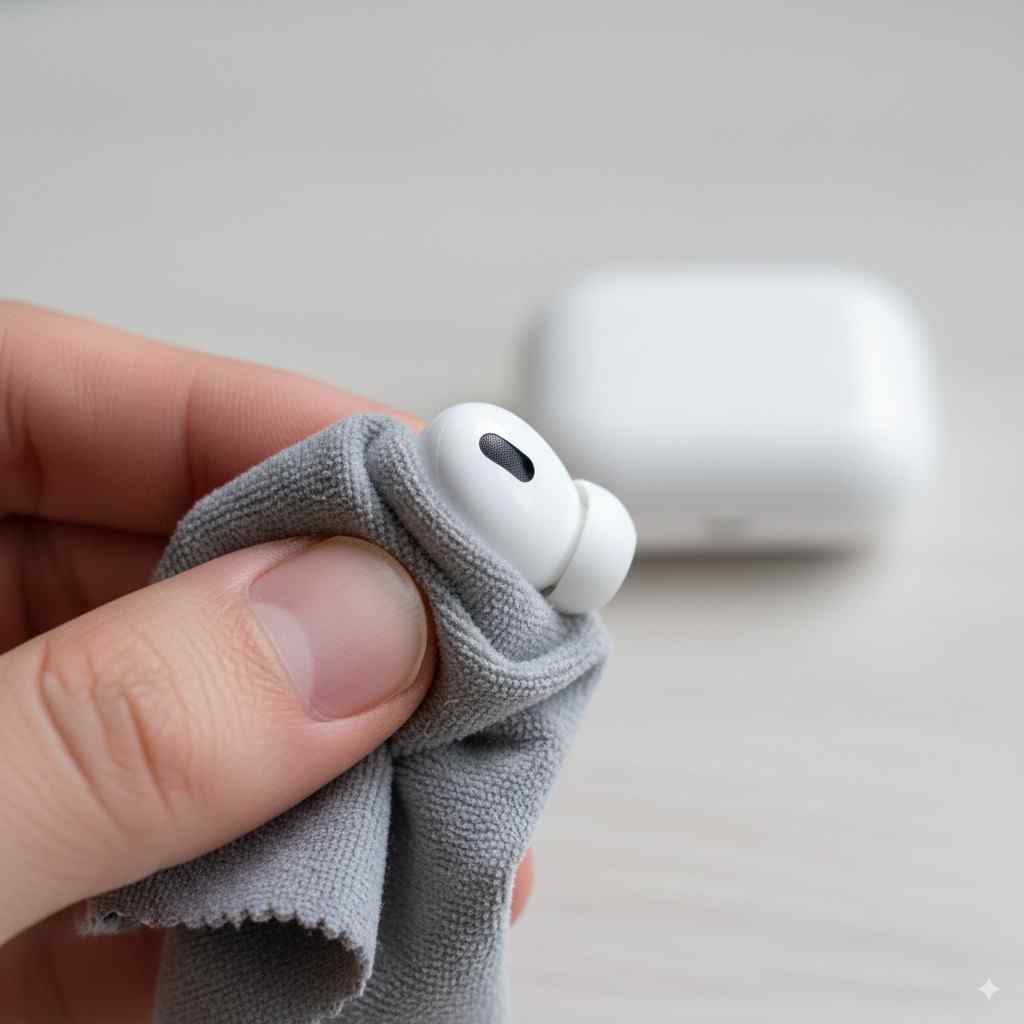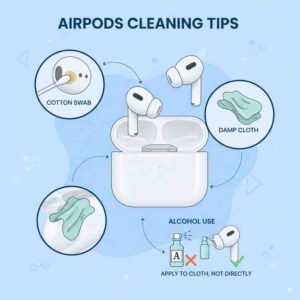Your AirPods are probably one of your most-used tech accessories, constantly tucked into your ears during commutes, workouts, and endless Zoom calls. But here’s the thing – when was the last time you actually cleaned your AirPods? If you’re like most people, the answer is probably “embarrassingly long ago” or “never.”
Actually, learning how to clean AirPods properly isn’t just about hygiene (though that’s important too). Regular cleaning can dramatically improve your sound quality, prevent potential ear infections, and keep your charging case working efficiently. Think about it – you wouldn’t wear the same pair of earphones for months without cleaning them, so why treat your expensive AirPods any differently?
The reality is that your AirPods collect earwax, dead skin cells, dust, and bacteria every single day. This buildup doesn’t just look gross – it can muffle your audio, interfere with the charging connection, and potentially cause ear irritation or infections. So, let’s dive into the comprehensive guide on how to clean your AirPods safely and effectively.
Table of Contents
How To Clean AirPods: A Simple Step

Gently wipe AirPods with a soft, dry, lint-free cloth. Use a slightly dampened cloth for stubborn dirt. Avoid liquids in openings, and clean the charging case separately with a dry cloth or soft brush to maintain performance and hygiene.
Top Cleaning Practices

• Use dry cotton swabs for speaker meshes – Prevents damage to delicate acoustic components while effectively removing wax and debris that can muffle sound quality.
• Clean with slightly damp cloth only – Moisture control prevents liquid damage to internal electronics while still removing oils, dirt, and bacteria from surfaces.
• Avoid liquids in any openings – Protects sensitive internal components from water damage that could permanently disable the AirPods’ functionality.
• Remove AirPods Pro ear tips before cleaning – Allows thorough cleaning of both the tips and the AirPods themselves, ensuring better hygiene and preventing buildup in hard-to-reach areas.
• Clean the charging case regularly – Maintains proper electrical connections and prevents debris from interfering with charging or transferring to clean AirPods.
• Use isopropyl alcohol sparingly (70% or less) – Provides effective disinfection for stubborn residue while being safe for the materials and coatings used in AirPods construction.
• Allow complete drying before use – Prevents moisture-related damage and ensures optimal performance when the AirPods are next used or charged.
• Clean weekly with regular use – Prevents excessive buildup of earwax, oils, and bacteria that can affect both hygiene and audio quality over time.
Why Clean Your AirPods & Earbuds Safely?
Health Risks You Can’t Ignore
Here’s something that might make you squirm a little: your ears naturally produce cerumen (earwax), and when you regularly use earbuds, you’re essentially creating a warm, moist environment that bacteria absolutely love. According to WIRED’s detailed analysis, the combination of earwax buildup and bacterial growth can lead to serious ear infections, especially if you share your earbuds with others or use them immediately after someone else has used them.
Tom’s Guide research reveals that dirty earbuds can harbor harmful bacteria like Staphylococcus and Streptococcus, which can cause painful outer ear infections (otitis externa). The warm, enclosed environment created by earbuds provides the perfect breeding ground for these microorganisms. Even more concerning, if you have small cuts or irritation in your ear canal, bacteria from dirty AirPods can enter and cause more serious infections.
The gross factor aside, think about this from a practical standpoint: if you’re experiencing frequent ear irritation, itching, or minor infections, your dirty AirPods might be the culprit. Many people don’t realize that the solution to their recurring ear problems might be as simple as establishing a regular cleaning routine.
Performance Issues From Neglect
Anyway, let’s talk about something you’ve probably noticed but maybe didn’t connect to cleanliness – muffled sound quality. When earwax, dust, and debris accumulate on the speaker mesh of your AirPods, it acts like a natural sound dampener. You might find yourself constantly adjusting the volume higher and higher, not realizing that the issue isn’t your hearing or the audio source, but simply clogged mesh blocking the sound waves.
The speaker grilles on AirPods are incredibly fine, designed to let sound through while keeping debris out. However, over time, microscopic particles build up in these tiny openings, creating an acoustic barrier. This doesn’t just affect volume – it can also impact the clarity of high frequencies, making your music sound muddy or voices in podcasts harder to understand.
Durability and Charging Efficiency
Here’s where it gets really expensive to ignore cleaning: charging problems. The Spruce’s comprehensive guide explains that grime buildup on the charging contacts can seriously disrupt the electrical connection between your AirPods and their case. You might notice that your AirPods aren’t charging to 100%, are taking longer to charge, or aren’t making proper contact in the case.
The charging case has delicate metal contacts that need to make a clean connection with the corresponding contacts on your AirPods. When these get covered with oils from your skin, lint from your pocket, or general dust and debris, the electrical resistance increases, leading to inefficient charging. In worst-case scenarios, this can permanently damage the charging mechanism, requiring expensive repairs or replacement.
How Often to Clean Your AirPods and Case
Light Maintenance: The 72-Hour Rule
So, how often should you actually clean these things? Real Simple’s expert recommendations suggest a light wipe-down every 72 hours of use. This doesn’t mean you need to do a deep clean every three days, but rather a quick exterior wipe with a clean, dry cloth after every few listening sessions.
This frequency makes sense when you consider how much contact your AirPods have with your skin and ear canal. Every time you use them, they’re collecting oils, dead skin cells, and earwax. A quick daily wipe prevents this buildup from becoming a bigger problem later.
Actually, I’d argue that if you’re someone who wears AirPods for several hours daily – whether for work calls, music, or podcasts – you should probably lean toward the more frequent end of this recommendation. Think of it like washing your hands: you wouldn’t wait three days between washes if you were handling things constantly, right?
Deep Cleaning: Monthly Maintenance
For deep cleaning sessions, Craftbymerlin’s detailed analysis and The Spruce both recommend monthly deep cleans for average users, but suggest increasing this frequency if you’re particularly active. If you’re hitting the gym regularly, running, or doing other activities that make you sweat while wearing your AirPods, you should probably deep clean them every two weeks.
Here’s the thing about sweat: it’s not just water. Sweat contains salts, proteins, and other compounds that can be particularly damaging to electronic components. When sweat dries, it leaves behind these residues, which can be corrosive over time. Plus, the combination of moisture and warmth creates an ideal environment for bacterial growth.
If you’re someone who forgets about maintenance (no judgment here), set a monthly reminder on your phone. Trust me, spending 15 minutes cleaning your AirPods monthly is much better than spending $200+ replacing them because they stopped working properly.
What You’ll Need for Proper AirPods Cleaning
For AirPods & AirPods Pro (Earbuds)
Before you start, gather the right tools. Using the wrong materials can actually damage your AirPods, so this part is crucial. Here’s what Apple Support officially recommends:
Soft lint-free or microfiber cloth: This is your go-to for general wiping. Avoid paper towels or tissues, as these can leave behind fibers or be too abrasive for the delicate surfaces.
Soft-bristled toothbrush: Apple specifically mentions using a children’s toothbrush because the bristles are gentler. You can also use a soft brush specifically designed for electronics cleaning. The key is that the bristles should be soft enough not to damage the mesh but firm enough to dislodge debris.
Cotton swabs (dry): These are perfect for cleaning around the smaller crevices and the stem of your AirPods. Make sure they’re completely dry – moisture can damage the internal components.
Micellar water and distilled water: This might surprise you, but Apple actually recommends micellar water for cleaning the speaker mesh. Micellar water is gentler than soap and designed to lift away oils and debris without leaving residue. You’ll also need distilled water for rinsing – tap water can contain minerals that leave deposits.
Cleaning putty (optional): Craftbymerlin’s guide mentions adhesive cleaning putty as an excellent tool for deep cleaning. This putty can be pressed into the speaker grilles to pull out debris that brushing can’t reach.
For the Charging Case
The charging case needs different tools because it has different vulnerabilities:
Soft-bristled brush or dry cotton swab: Perfect for cleaning out the charging ports and removing debris from the hinge areas.
Slightly damp lint-free cloth: Apple Support, Better Homes & Gardens, and The Spruce all recommend using either fresh water or 70% isopropyl alcohol for stubborn stains. The key word here is “slightly” – you want the cloth barely damp, not wet.
Clean Your AirPods Meshes: The Apple-Approved Method
The Micellar Water Technique
This is where things get interesting. Apple’s official method for cleaning the speaker mesh might seem unusual, but it’s specifically designed to be effective while protecting the delicate components behind the mesh. Here’s the step-by-step process recommended by Apple Support:
- Dip your soft-bristled toothbrush in micellar water – just the tips of the bristles, not the entire brush head
- Gently brush the mesh in small circular motions for about 15 seconds – don’t apply pressure, let the bristles do the work
- Blot the mesh with a dry cloth to remove the micellar water and loosened debris
- Repeat this process 3 times – this ensures you’re getting multiple passes at stubborn buildup
- Rinse your brush thoroughly with distilled water – this removes any micellar water residue
- Use the clean, damp brush to rinse the mesh the same way – gentle circular motions for another 15 seconds
- Let your AirPods dry completely for at least 2 hours – this is crucial; don’t skip this step
Actually, the reason Apple recommends micellar water specifically is pretty clever. Unlike soap, which can leave residue, or alcohol, which might be too harsh for the mesh material, micellar water contains tiny oil molecules (micelles) that attract and lift away oils and debris without requiring harsh scrubbing.
Clean Your AirPods 4 Meshes
The AirPods 4 follow the exact same micellar water method described above. The newer model has the same type of mesh construction as previous generations, so Apple’s cleaning recommendations remain consistent. The key difference with AirPods 4 is being extra gentle around the updated speaker design – the internal components are more advanced, so any water that gets past the mesh could potentially cause more expensive damage.
Clean Your AirPods 3 Meshes
For AirPods 3, you’ll use the identical micellar water technique. However, many users report that AirPods 3 seem to accumulate debris slightly faster than previous models, possibly due to the updated acoustic design. If you’re an AirPods 3 user, you might want to lean toward the more frequent cleaning schedule – every few weeks rather than monthly.
Clean the Body of Your AirPods
Safe Water Usage
Cleaning the main body of your AirPods is actually more straightforward than the mesh cleaning, but there are still important precautions. Apple Support recommends wiping the body with a cloth slightly dampened with fresh water, then drying the AirPods completely for at least 2 hours before using them again.
Here’s what’s important to understand: AirPods have some water resistance, but they’re not waterproof. The difference matters. You can handle some moisture on the exterior surfaces, but you should never run them directly under water or submerge them. The seals around the charging contacts and other openings aren’t designed to handle direct water exposure.
When dampening your cloth, aim for what cleaning professionals call “barely damp” – if you can squeeze any water out of the cloth, it’s too wet. You want just enough moisture to help lift oils and stuck-on debris, but not enough to risk water getting into the internal components.
What to Avoid
The Sun’s cleaning guide emphasizes avoiding sharp tools or abrasive materials when cleaning the AirPods body. This means no toothpicks, no steel wool, no rough cloths, and definitely no scraping with your fingernails. The plastic and metal surfaces of AirPods can scratch relatively easily, and once you’ve scratched the surface, it becomes a place where dirt and bacteria can accumulate more easily.
So, stick to gentle wiping motions with appropriate materials. If you encounter stubborn spots, use a slightly dampened cotton swab to work at them gently, rather than applying more pressure or using harsher tools.
Clean the Charging Case of Your AirPods
Port Cleaning Strategy
The charging case often gets neglected, but it’s actually one of the most important components to keep clean. Apple Support recommends using a soft-bristled brush to remove debris from the charging port, but here’s the crucial part: never poke or insert anything into the port.
The charging port contains delicate pins and connections that can be easily damaged. Instead of trying to dig out debris, use gentle brushing motions to coax it out. If debris is really stuck, try using a can of compressed air from a distance, but be careful not to push debris further into the port.
Actually, here’s a pro tip: if you carry your AirPods case in your pocket, consider using a small pouch or case protector. Pockets are full of lint, dust, and other debris that gravitates toward small openings like charging ports.
Exterior Case Maintenance
For the exterior of the case, you can be a bit more aggressive with cleaning since there are fewer sensitive components. Apple Support, Better Homes & Gardens, and The Spruce all recommend starting with a lint-free cloth for general cleaning, then moving to a lightly dampened cloth with isopropyl alcohol for stubborn stains.
The 70% isopropyl alcohol concentration is important – higher concentrations can be too harsh for some plastics, while lower concentrations aren’t as effective at killing bacteria and breaking down oils. After using any cleaning solution, always follow up with a dry cloth and make sure everything is completely dry before closing the case or inserting your AirPods.
How to Clean Your AirPods Pro
Unique Considerations for Pro Models
AirPods Pro require some special attention because of their unique design features. The silicone ear tips, the different mesh configuration, and the more complex internal components all need slightly different care approaches.
Clean Your AirPods Pro 2 Meshes
For AirPods Pro 2, you’ll use the same micellar water method described earlier, but with extra attention to the multiple mesh areas. The Pro models have mesh on both the speaker output and the microphone input, so you’ll need to clean both areas using the same gentle circular brushing technique.
Apple Support emphasizes being particularly gentle with AirPods Pro mesh because the noise-canceling and transparency features depend on these openings being completely clear. If debris blocks the microphone mesh, you might notice issues with noise cancellation effectiveness or call quality.
Clean the Body of Your AirPods Pro
The body cleaning for AirPods Pro follows the same principles as regular AirPods, but there are a few additional considerations. The Pro models have more complex button mechanisms and additional sensors, so be particularly careful around the force sensor stem and any charging contact points.
Use the same slightly damp cloth technique, but pay extra attention to the areas around the removable ear tips where debris can accumulate. Don’t forget to clean the stem thoroughly, as this is the part you touch most often and where oils from your fingers tend to build up.
Clean the Ear Tips of Your AirPods Pro
Proper Tip Removal and Cleaning
This is where AirPods Pro maintenance gets significantly different from regular AirPods. The silicone ear tips can be completely removed, which makes them much easier to clean thoroughly. Here’s Apple’s recommended process:
- Remove the ear tips by pulling them straight off – don’t twist or bend them, as this can damage the attachment mechanism
- Tap the tips downward on a dry cloth to expel any moisture or loose debris
- Rinse the tips with fresh water only – no soap, no alcohol, just plain water
- Dry the tips completely before reattaching – this is crucial to prevent moisture from getting into the AirPods
- Reattach by aligning carefully and pressing until you feel them click into place
Actually, here’s something many people don’t realize: you should replace your silicone ear tips periodically, even with regular cleaning. Over time, the silicone can develop tiny cracks or become less flexible, which affects both comfort and the seal needed for optimal noise cancellation. If you notice your AirPods Pro aren’t staying in your ears as well as they used to, or if the noise cancellation seems less effective, worn ear tips might be the culprit.
Clean the Charging Case of Your AirPods Pro
The AirPods Pro case cleaning follows the same principles as the regular AirPods case, but there are a few Pro-specific considerations. The Pro case has a slightly different internal layout to accommodate the different shape of the earbuds, so pay attention to cleaning around the shaped recesses where the AirPods sit.
Apple Support recommends the same brush-out-debris and wipe-exterior approach, but be particularly careful around the charging contacts since the Pro models have a slightly different charging interface.
Avoid Skin Irritation Through Proper Hygiene
Post-Workout Cleaning Protocols
Here’s something that’s particularly important for active users: Apple Support specifically recommends cleaning your AirPods after exposure to sweat or products like sunscreen and lotion. These substances can cause skin irritation when they build up on surfaces that have prolonged contact with your skin.
If you’re someone who works out with your AirPods regularly, consider developing a post-exercise cleaning routine. A quick wipe-down with a dry cloth immediately after your workout can prevent sweat from drying and forming stubborn residue. For more intense workouts, you might want to use a slightly damp cloth with distilled water to remove salt residue from dried sweat.
Material Sensitivities
Actually, if you’re experiencing recurring ear irritation, it might be worth checking what materials your AirPods are made from and whether you have any known allergies. Some people are sensitive to certain plastics or metals used in electronic devices. In these cases, more frequent cleaning becomes even more important, as it reduces the contact time between your skin and any potentially irritating substances.
General Cleaning Tips for Other Earbuds & Over-Ear Headphones
Wireless Earbuds with Silicone Tips
The cleaning principles we’ve discussed for AirPods Pro apply broadly to other wireless earbuds with silicone tips. Tom’s Guide and WIRED both recommend soaking silicone tips in warm, soapy water for deeper cleaning, but this should only be done with tips that are designed to be fully removable and water-safe.
For earbuds from other manufacturers, always check the specific cleaning recommendations in your device’s manual, as different materials and coatings may have different requirements.
Over-Ear and On-Ear Headphones
Tiger Cleaning Services provides excellent guidance for larger headphones: remove any removable cushions and wipe all surfaces with a cloth dampened with mild detergent solution, then dry thoroughly. The key with larger headphones is paying attention to fabric components, which can harbor bacteria and odors if not cleaned regularly.
For leather or faux leather components, use specialized leather cleaning products rather than general cleaners, as harsh chemicals can cause cracking or discoloration.
Safe Cleaning Without Damage: Critical Don’ts
Chemical Restrictions
Here’s where a lot of people make expensive mistakes. Real Simple, The Sun, and Better Homes & Gardens all emphasize the same critical point: never use bleach, hydrogen peroxide, harsh chemicals, or abrasive cleaners on your AirPods.
These substances can damage the plastic components, discolor surfaces, corrode metal contacts, and potentially create toxic residues that you definitely don’t want near your ears. Stick to the Apple-approved cleaning solutions: fresh water, distilled water, 70% isopropyl alcohol (for cases only), and micellar water for mesh cleaning.
The Compressed Air Trap
Craftbymerlin’s detailed analysis makes an important point that many people miss: avoid using compressed air directly on AirPods. While compressed air seems like a logical choice for blowing out debris, it can actually push particles deeper into the internal components where they become much harder to remove and can cause damage.
If you do need to use compressed air, use it from a significant distance and at an angle that blows debris away from the device, not toward openings or mesh areas.
Physical Damage Prevention
The Sun’s guide emphasizes never inserting objects into ports or mesh areas. This includes toothpicks, paper clips, bobby pins, or any other small tools you might think would help dig out debris. These openings are designed with specific tolerances, and forcing objects into them can permanently damage the internal components.
Troubleshooting & Maintenance
When Clean Isn’t Clean Enough
So what do you do if you’ve followed all the cleaning steps but your AirPods still don’t sound right or aren’t charging properly? First, make sure everything is completely dry. Sometimes what seems like ongoing issues is actually just residual moisture affecting performance. Let your AirPods dry for several hours longer and test again.
If mesh cleaning doesn’t improve sound quality, the issue might be more complex. Sometimes debris gets pushed so deep into the mesh that it requires professional cleaning, or the mesh itself may be damaged and need replacement.
Charging Contact Maintenance
The Spruce points out that dirty charging contacts are one of the most common causes of charging issues that people don’t think to address. If your AirPods aren’t charging reliably, clean both the contacts on the AirPods and the corresponding contacts in the case with a dry cotton swab, then test the connection.
Replacement Guidelines
Eventually, some components will need replacement regardless of how well you maintain them. Silicone ear tips typically need replacement every 6-12 months with regular use. If you notice that your tips are becoming stiff, developing cracks, or not sealing as well as they used to, it’s time for new ones. Using genuine Apple replacements or high-quality third-party alternatives ensures continued performance and safety.
FAQ Section
Can I use alcohol on my AirPods? Apple recommends 70% isopropyl alcohol only for the charging case exterior, not on the AirPods themselves. For the earbuds, stick to water and micellar water as recommended by Apple Support.
How often should I clean my AirPods? Light cleaning every 72 hours of use, with deep cleaning monthly. Increase frequency if you use them for workouts or in dusty environments.
Does cleaning void my warranty? Following Apple’s official cleaning methods will not void your warranty. However, damage caused by improper cleaning methods or unauthorized disassembly will void warranty coverage.
Can I use compressed air to clean my AirPods? Apple does not recommend compressed air, as it can push debris deeper into the device. Use soft brushes and gentle wiping instead.
How do I clean without damaging the warranty? Follow only Apple’s official cleaning recommendations found on Apple Support. Use only approved materials and methods, and never disassemble your AirPods or attempt repairs yourself.
Printable Cleaning Checklist
| Task | Frequency | Notes |
|---|---|---|
| Wipe exterior | Every few uses / weekly | Use dry, lint-free cloth |
| Light mesh brushing | Weekly | Dry soft-bristled brush only |
| Deep mesh clean (micellar water) | Monthly | Follow Apple’s 3-step process |
| Clean ear tips (Pro only) | Monthly or after sweat | Remove, rinse with water, dry completely |
| Clean charging case | Monthly or as needed | Brush debris, wipe exterior |
| Replace silicone tips (Pro only) | Every 6-12 months | When worn or damaged |
Community Tips and Advanced Techniques
Reddit User Insights
The AirPods community has developed some creative cleaning solutions over the years. One popular Reddit technique involves placing a dozen drops of isopropyl alcohol on a cotton swab and carefully cleaning the internal notches of the charging case where lint tends to accumulate. This method requires extreme care to avoid getting alcohol on electronic components.
Another community favorite is using cleaning putty by pressing it into the speaker grille and gently peeling it away. As mentioned in Craftbymerlin’s guide, this putty method can pull out debris that brushing simply can’t reach, but it requires high-quality cleaning putty designed for electronics.
User Experience Examples
Consider two different users with vastly different cleaning needs:
The Gym Enthusiast: Uses AirPods Pro for 2-hour daily workouts, including running and weightlifting. This user needs weekly deep cleaning with particular attention to sweat and salt buildup. They’ve developed a routine of immediate post-workout wiping and weekly micellar water cleaning, with ear tip replacement every 4-6 months due to heavy use.
The Remote Worker: Uses AirPods for 6+ hours daily for calls and music while working from home. Their cleaning needs focus more on earwax buildup and general hygiene rather than sweat management. Monthly deep cleaning works well, with emphasis on mesh maintenance for call quality.
Final Thoughts: Making Cleaning a Habit
Actually, the most important thing about AirPods maintenance isn’t knowing all the detailed techniques – it’s making cleaning a regular habit. Set a reminder, keep a microfiber cloth handy, and don’t let buildup become a major problem.
Remember, your AirPods are a significant investment. With proper care, they should provide years of excellent audio quality and reliable performance. The few minutes you spend on regular maintenance will pay for themselves many times over in extended device life and better user experience.
Whether you’re using the latest AirPods Pro 2 or still rocking an older pair of standard AirPods, these cleaning principles apply universally. Stay consistent with your maintenance routine, use only Apple-approved cleaning methods, and don’t hesitate to replace consumable parts like ear tips when they show wear.
Your ears – and your wallet – will thank you for taking proper care of these remarkable little devices.



